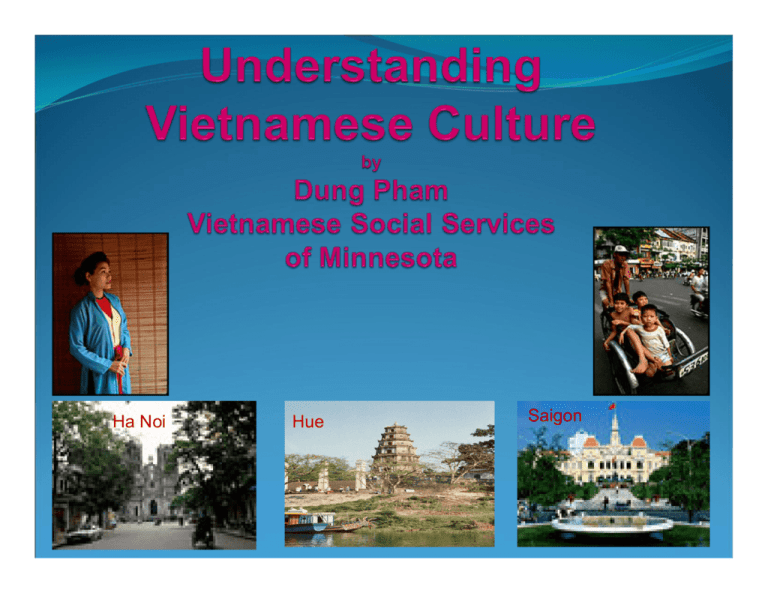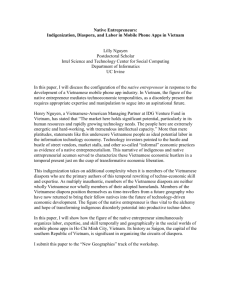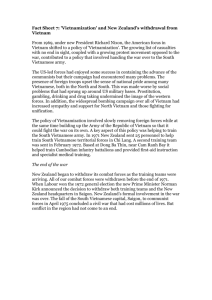Understanding of Vietnamese Culture
advertisement

Ha Noi Hue Saigon Country Name: Vietnam Location: Southeastern Asia Geography: - Divided into three parts: North, Middle and South. People Population: 86, 116,559 (July 2008 est.) Ethnic group - Kinh (Vietnamese) 86.2% Tay - Tay 1.9% - Thai 1.7% - Muong 1.5% - Khome (Cambodian) 1.4% Dzao - Hoa (Chinese) 1.1% - Nung (Nun) 1.1% - Hmong 1% - Others 4.1% (1999 Census) Thai Vietnamese Hmong Religion in Vietnam Buddhist 85% (founded in 500 B.C. and brought to Vietnam in the 1st Century A.D.) Christianity 8% Cao Dai 3% Others 4% Saigon Cathedral Cao Dai Temple An Quang Temple Language Vietnamese use the Latin alphabet, introduced by the French colonizers Every word has only one syllable and its meaning and pronunciation is based on the tone (e.g. á, à, ả, ã, â, ă, ạ) Vietnamese is spoken in many dialects, and there are other minority languages as well Each region has its own pronunciation. For example: the word “mother” will be “mẹ” in North Vietnam, “má” in the South, and “mạ” in the middle Culture & Tradition Marriage has a vital role in Vietnamese culture and tradition In the past, most marriages were arranged by parents or extended family and children might only sometimes be consulted. The groom and bride may have only met on the day of the engagement. Now, this has changed in modern Vietnam. Single girls and boys can meet each other before the wedding and arrange marriage by themselves. Parental permission is not as important as in the past. Culture and Tradition (cont.) Funerals: “the sense of death is that of finality”, so the funeral must be solemnly organized. The funeral follows many steps, depending on the family’s belief, and often takes place over three days after the day of death: Keep the body at home for worship and prayer Bury the body Open the grave for worship (3 days after the day of the person’s death) After the funeral is over, the family: Brings rice to the family alter for 49 days Ends the tears (after 100 days) Commemorates the 1st anniversary of the death ( ending of mourning festival). Culture & Tradition (cont.) Celebration: there are many celebrations, ceremonies, and worship events throughout the year: - New Year celebration (Tet) takes place for the first three days of the year, Jan 1,2,and 3 (following the Chinese calendar) - Celebration of the middle of the year (May 5, following the Chinese calendar) - Mid-Autumn Festival (Tet Trung Thu) held on Aug 15 (following the Chinese calendar). - Christmas (for Christians, following the Western calendar) - Commemorations and ancestor ceremonies occur throughout the year as well Communication Vietnamese must consider many things in communication and conversation: - Children are taught to think deeply before they speak - Direct eye contact is encouraged while communicating - Disagreeing with an authoritative speaker is considered the same as challenging the senior person’s social status - A smile is appropriate as a response to an expression such as “Thank you” or “I am sorry”. When a person pays a compliment to another person, a “thank you” is not expected in return. Instead, the recipient will acknowledge it with a smile. Vietnamese Value System Has been deeply affected by Confucianism, introduced from China during a thousand years of Chinese rule. It has four basic components: Allegiance to the family and country Reputation Love of learning Respect for others Vietnamese Value System (Cont.) Allegiance to the family and country Keep the family at the center of one’s life Citizens are taught from an early age to forget their own interests for the sake of the country Reputation - is referred to as “a fragrant name” and is more precious than anything else in the world. There is a Vietnamese proverb: “After death, a tiger leaves behind his skin, a man leaves his reputation” Vietnamese Value System (Cont.) Love of learning - The Vietnamese common man has a great love of knowledge and learning. They also conceive that knowledge(tài) and virtue (đức) are two complementary aspects of the ideal man. Respect for others The concept of respect is paramount in the family There are different words to address persons, according to their age and gender. In society, respect is based on position, status and age. Traditional Family Structure In the past: Vietnamese families were patriarchal: the man always took the lead Divorce was legal but not common in Vietnamese society: a wife was expected to live in an unhappy marriage and sacrifice her life for her children rather than divorce Parental leadership in the family was considered a rule Children must obey their parents and a certain physical punishment was not considered an abuse. Unmarried boys and girls are not free to date when and with whom they please. Cultural Shifting In modern times, the Vietnamese culture and is shifting and changing The wife’s role in the family is changing. More independent Works outside the family More equal to the husband and even though he takes the lead in the family Cultural Shifting (Cont.) Divorce is beginning to be accepted, but it is still rare Children are becoming more independent and allowed to speak out their own ideas in the family Parents are beginning to listen to their children and talk to them when they make a mistake, rather than physically punishing them The relationship between unmarried girls and boys is more open, and healthy interaction needs to be encouraged Vietnamese in the U.S. An estimated 1.6 million Vietnamese live in the United States California has the biggest Vietnamese population and Texas has the second largest Vietnamese population. Minnesota has the 13th largest Vietnamese population of all the states. There are approximately 25, 000 Vietnamese in Minnesota. About 85% of Minnesota’s Vietnamese live in the Twin Cities metropolitan area. The remaining 15% live in places such as St. Cloud, Rochester, and Duluth. The Waves of Immigration Vietnamese came to America in three major waves: - Military officers and their families came at the end of the war in 1975. - “Boat people” came in the early 1980’s - Prisoners released from the Communist “re-education” camps in the 1990’s - Vietnamese immigrants are still coming to the U.S. under family sponsorship. Settlement in Minnesota Vietnamese refugees were sponsored by churches and individuals in Minnesota Many Vietnamese came to Minnesota from other states, or from Vietnam under family reunification regulations Vietnamese choose to live in Minnesota because of the State’s strong economy, excellent health and social services, and friendly people. Social Adjustment Many Vietnamese have made a successful transition to America, but some struggle with barriers such as lack of transferable job skills, language and cultural differences, and the psychological effects of war and displacement. Health Issues Priority health concerns: • Tobacco use • Cancer awareness • Nutrition • Access to Health Care Tobacco Use Vietnamese cultural tradition holds that sharing tobacco is a sign of hospitality Tobacco use is a solution for depression Tobacco use nevertheless becomes a habit Transition from traditional tobacco to commercial tobacco Cancer Awareness For some people, there is a stigma associated with cancer Some people believe cancer is caused by bad karma and can not be cured Other Vietnamese think cancer should be treated by a spirit doctor or Eastern medicine Some distrust Western medicine in cancer treatment Many are not familiar with preventive care Nutrition In Vietnam and America, a lot of Vietnamese eat raw meat and fish Vietnamese diet consists of a lot of fat and red meat instead of vegetables and fruits Sweet foods are popular In America, eat fast and junk food, youth especially – risk of diabetes Don’t have time to cook Access to Health Care Lack of information about health and the health care system in Minnesota Language barrier Unfamiliarity with mainstream agencies Immigrant status is a barrier Transportation – women elders don’t drive, unfamiliar with public transportation Traditional Health Care Beliefs Serious illness is kept a secret inside the family Females are hesitant to see a male doctor Suffering is predetermined and inevitable Counseling is not preferred in treatment Treatment methods of the Western medicine are distrusted by people. How to work effectively with the Vietnamese community Understand the differences and similarities between cultures and traditions Be willing to learn and share: - Participate in community events to understand the Vietnamese culture - Share your own culture Be aware of ways to work around the language difference Be aware of the difference between immigrant and refugee status How to work effectively with the Vietnamese community (Cont.) Develop personal and organizational cultural competency in working with Vietnamese individuals and families Identify the strengths of the Vietnamese community to maximize effectiveness such as, eagerness to learn, friendliness, willingness to work together. Use language-appropriate materials Seek the advice of Vietnamese professionals in the field Contact information For more information about the Vietnamese Culture, please contact: Dung Pham (651) 641-7270 dungpham@vssmn.org Thank you Cảm ơn
![vietnam[1].](http://s2.studylib.net/store/data/005329784_1-42b2e9fc4f7c73463c31fd4de82c4fa3-300x300.png)


